KIA Sorento 2006 1.G Workshop Manual
Manufacturer: KIA, Model Year: 2006, Model line: Sorento, Model: KIA Sorento 2006 1.GPages: 312, PDF Size: 5.21 MB
Page 51 of 312
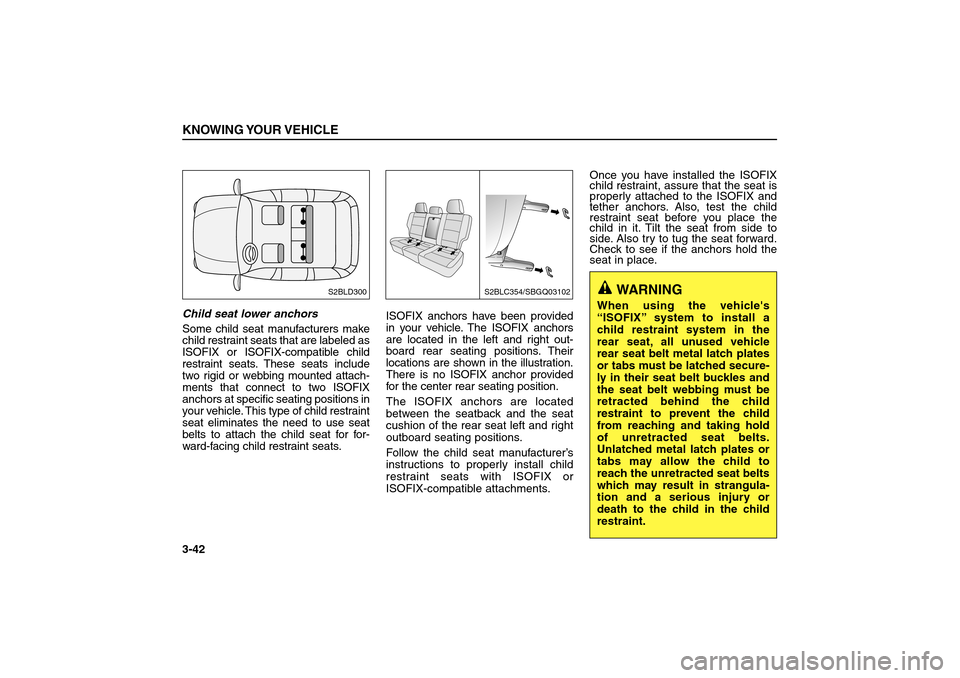
Child seat lower anchors
Some child seat manufacturers make
child restraint seats that are labeled as
ISOFIX or ISOFIX-compatible child
restraint seats. These seats include
two rigid or webbing mounted attach-
ments that connect to two ISOFIX
anchors at specific seating positions in
your vehicle. This type of child restraint
seat eliminates the need to use seat
belts to attach the child seat for for-
ward-facing child restraint seats.ISOFIX anchors have been provided
in your vehicle. The ISOFIX anchors
are located in the left and right out-
board rear seating positions. Their
locations are shown in the illustration.
There is no ISOFIX anchor provided
for the center rear seating position.
The ISOFIX anchors are located
between the seatback and the seat
cushion of the rear seat left and right
outboard seating positions.
Follow the child seat manufacturer’s
instructions to properly install child
restraint seats with ISOFIX or
ISOFIX-compatible attachments.Once you have installed the ISOFIX
child restraint, assure that the seat is
properly attached to the ISOFIX and
tether anchors. Also, test the child
restraint seat before you place the
child in it. Tilt the seat from side to
side. Also try to tug the seat forward.
Check to see if the anchors hold the
seat in place.KNOWING YOUR VEHICLE3-42
S2BLC354/SBGQ03102
S2BLD300
WARNING
When using the vehicle's
“ISOFIX” system to install a
child restraint system in the
rear seat, all unused vehicle
rear seat belt metal latch plates
or tabs must be latched secure-
ly in their seat belt buckles and
the seat belt webbing must be
retracted behind the child
restraint to prevent the child
from reaching and taking hold
of unretracted seat belts.
Unlatched metal latch plates or
tabs may allow the child to
reach the unretracted seat belts
which may result in strangula-
tion and a serious injury or
death to the child in the child
restraint.
BL-ENG (CAN)-3.qxd 7/28/05 5:52 PM Page 42
Page 52 of 312
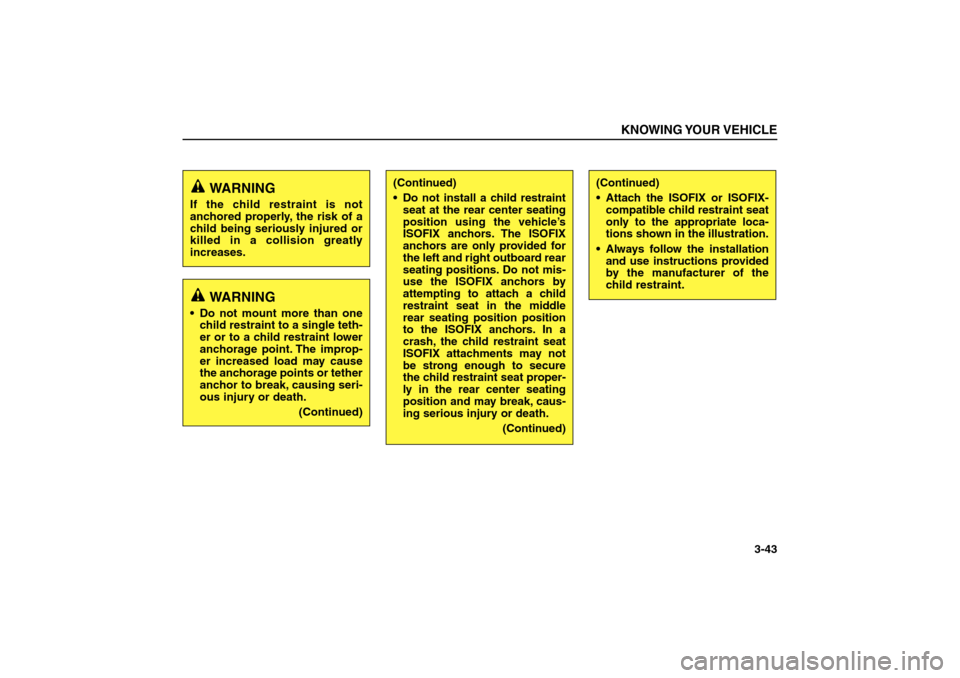
KNOWING YOUR VEHICLE
3-43
WARNING
If the child restraint is not
anchored properly, the risk of a
child being seriously injured or
killed in a collision greatly
increases.
(Continued)
Do not install a child restraint
seat at the rear center seating
position using the vehicle’s
ISOFIX anchors. The ISOFIX
anchors are only provided for
the left and right outboard rear
seating positions. Do not mis-
use the ISOFIX anchors by
attempting to attach a child
restraint seat in the middle
rear seating position position
to the ISOFIX anchors. In a
crash, the child restraint seat
ISOFIX attachments may not
be strong enough to secure
the child restraint seat proper-
ly in the rear center seating
position and may break, caus-
ing serious injury or death.
(Continued)
(Continued)
Attach the ISOFIX or ISOFIX-
compatible child restraint seat
only to the appropriate loca-
tions shown in the illustration.
Always follow the installation
and use instructions provided
by the manufacturer of the
child restraint.
WARNING
Do not mount more than one
child restraint to a single teth-
er or to a child restraint lower
anchorage point. The improp-
er increased load may cause
the anchorage points or tether
anchor to break, causing seri-
ous injury or death.
(Continued)
BL-ENG (CAN)-3.qxd 7/28/05 5:52 PM Page 43
Page 53 of 312
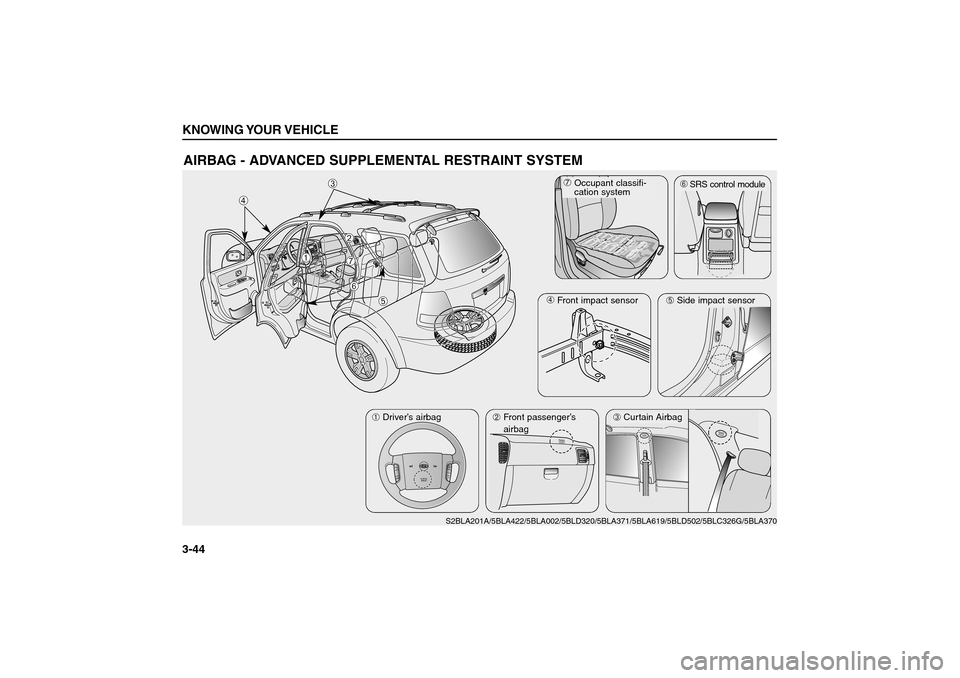
KNOWING YOUR VEHICLE3-44AIRBAG - ADVANCED SUPPLEMENTAL RESTRAINT SYSTEM
SRSAIRBAG
RES
ACCELC
O
A
S
T
S
E
T
PWRS
E
E
K
CANCEL
S
R
SAIRBAG
➀Driver’s airbag
➁Front passenger’s
airbag
➃Front impact sensor
➅SRS control module
S2BLA201A/5BLA422/5BLA002/5BLD320/5BLA371/5BLA619/5BLD502/5BLC326G/5BLA370
SRSAIRBAG
➄Side impact sensor
➆Occupant classifi-
cation system
SRSAIRBAG
➂Curtain Airbag
➀
➁
➂
➃
➄
➅➆
BL-ENG (CAN)-3.qxd 7/28/05 5:52 PM Page 44
Page 54 of 312
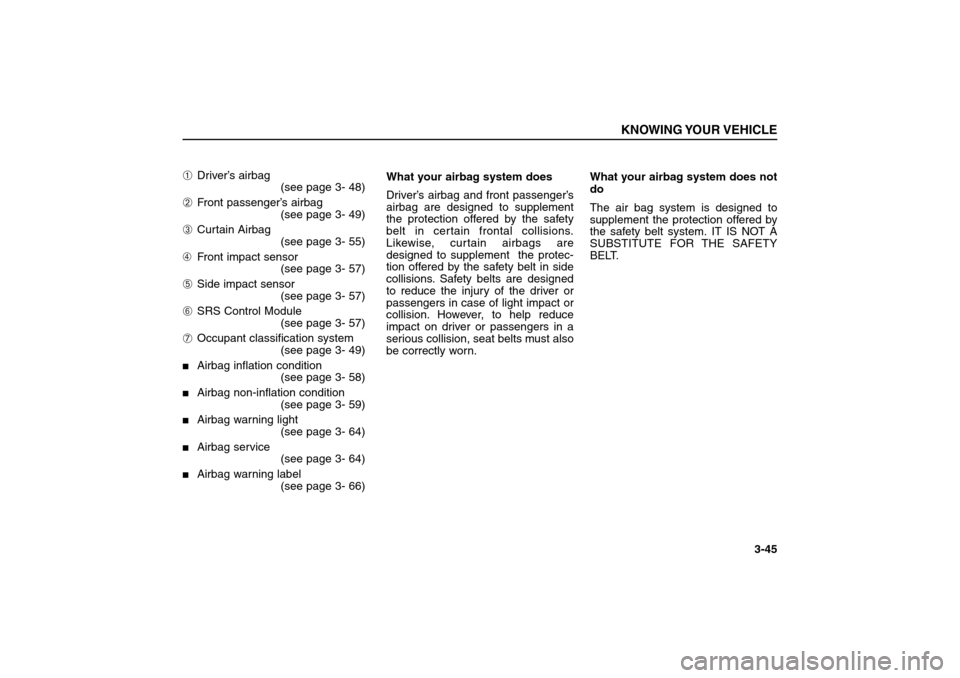
➀
Driver’s airbag
(see page 3- 48)
➁
Front passenger’s airbag
(see page 3- 49)
➂
Curtain Airbag
(see page 3- 55)
➃Front impact sensor
(see page 3- 57)
➄
Side impact sensor
(see page 3- 57)
➅
SRS Control Module
(see page 3- 57)
➆
Occupant classification system
(see page 3- 49)
Airbag inflation condition
(see page 3- 58)
Airbag non-inflation condition
(see page 3- 59)
Airbag warning light
(see page 3- 64)
Airbag service
(see page 3- 64)
Airbag warning label
(see page 3- 66)What your airbag system does
Driver’s airbag and front passenger’s
airbag are designed to supplement
the protection offered by the safety
belt in certain frontal collisions.
Likewise, curtain airbags are
designed to supplement the protec-
tion offered by the safety belt in side
collisions. Safety belts are designed
to reduce the injury of the driver or
passengers in case of light impact or
collision. However, to help reduce
impact on driver or passengers in a
serious collision, seat belts must also
be correctly worn.What your airbag system does not
do
The air bag system is designed to
supplement the protection offered by
the safety belt system. IT IS NOT A
SUBSTITUTE FOR THE SAFETY
BELT.
KNOWING YOUR VEHICLE
3-45
BL-ENG (CAN)-3.qxd 7/28/05 5:52 PM Page 45
Page 55 of 312
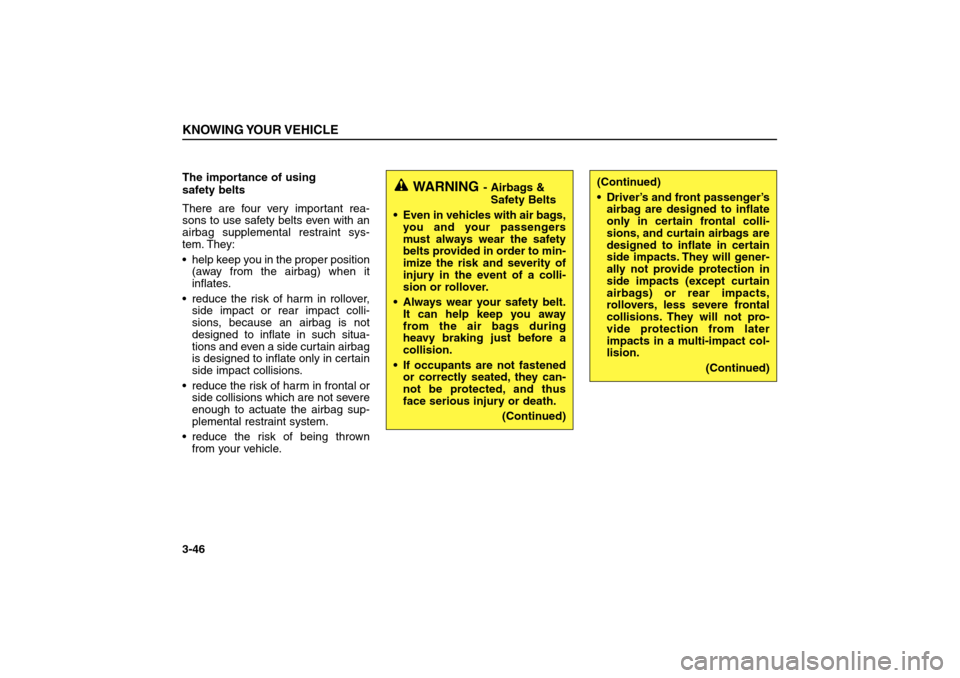
The importance of using
safety belts
There are four very important rea-
sons to use safety belts even with an
airbag supplemental restraint sys-
tem. They:
help keep you in the proper position
(away from the airbag) when it
inflates.
reduce the risk of harm in rollover,
side impact or rear impact colli-
sions, because an airbag is not
designed to inflate in such situa-
tions and even a side curtain airbag
is designed to inflate only in certain
side impact collisions.
reduce the risk of harm in frontal or
side collisions which are not severe
enough to actuate the airbag sup-
plemental restraint system.
reduce the risk of being thrown
from your vehicle.KNOWING YOUR VEHICLE3-46
WARNING
- Airbags &
Safety Belts
Even in vehicles with air bags,
you and your passengers
must always wear the safety
belts provided in order to min-
imize the risk and severity of
injury in the event of a colli-
sion or rollover.
Always wear your safety belt.
It can help keep you away
from the air bags during
heavy braking just before a
collision.
If occupants are not fastened
or correctly seated, they can-
not be protected, and thus
face serious injury or death.
(Continued)
(Continued)
Driver’s and front passenger’s
airbag are designed to inflate
only in certain frontal colli-
sions, and curtain airbags are
designed to inflate in certain
side impacts. They will gener-
ally not provide protection in
side impacts (except curtain
airbags) or rear impacts,
rollovers, less severe frontal
collisions. They will not pro-
vide protection from later
impacts in a multi-impact col-
lision.
(Continued)
BL-ENG (CAN)-3.qxd 7/28/05 5:52 PM Page 46
Page 56 of 312
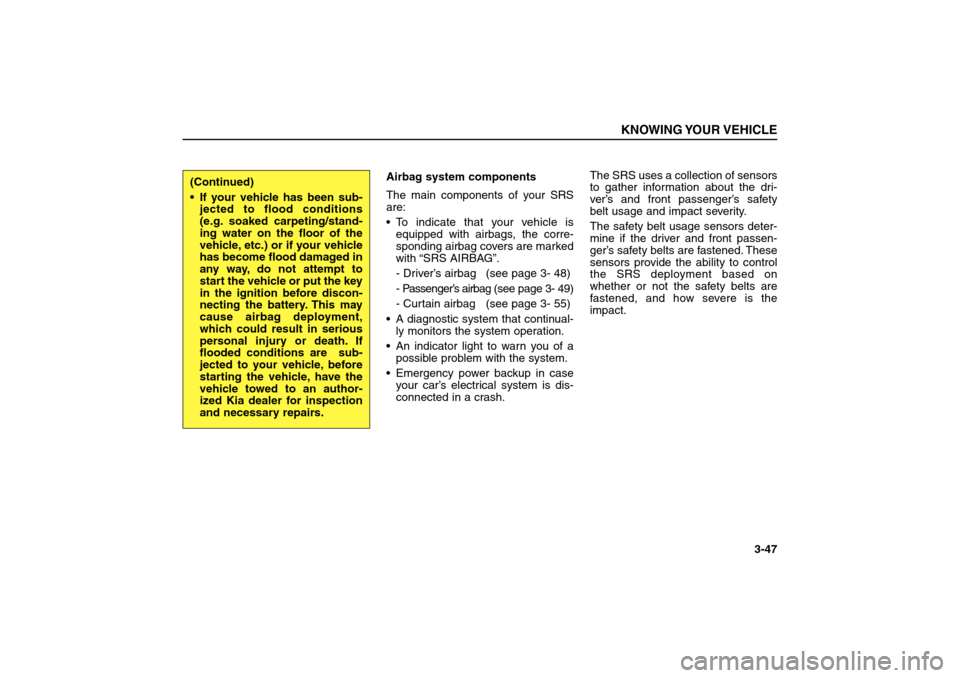
Airbag system components
The main components of your SRS
are:
To indicate that your vehicle is
equipped with airbags, the corre-
sponding airbag covers are marked
with “SRS AIRBAG”.
- Driver’s airbag (see page 3- 48)
- Passenger’s airbag(see page 3- 49)
- Curtain airbag (see page 3- 55)
A diagnostic system that continual-
ly monitors the system operation.
An indicator light to warn you of a
possible problem with the system.
Emergency power backup in case
your car’s electrical system is dis-
connected in a crash.The SRS uses a collection of sensors
to gather information about the dri-
ver’s and front passenger’s safety
belt usage and impact severity.
The safety belt usage sensors deter-
mine if the driver and front passen-
ger’s safety belts are fastened. These
sensors provide the ability to control
the SRS deployment based on
whether or not the safety belts are
fastened, and how severe is the
impact.
KNOWING YOUR VEHICLE
3-47
(Continued)
If your vehicle has been sub-
jected to flood conditions
(e.g. soaked carpeting/stand-
ing water on the floor of the
vehicle, etc.) or if your vehicle
has become flood damaged in
any way, do not attempt to
start the vehicle or put the key
in the ignition before discon-
necting the battery. This may
cause airbag deployment,
which could result in serious
personal injury or death. If
flooded conditions are sub-
jected to your vehicle, before
starting the vehicle, have the
vehicle towed to an author-
ized Kia dealer for inspection
and necessary repairs.
BL-ENG (CAN)-3.qxd 7/28/05 5:52 PM Page 47
Page 57 of 312
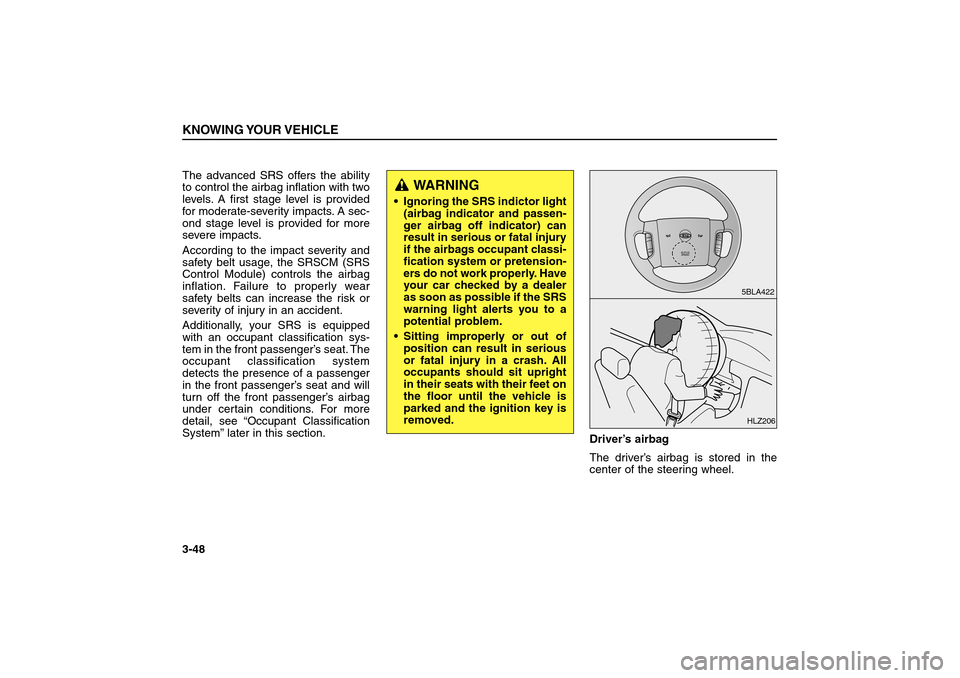
The advanced SRS offers the ability
to control the airbag inflation with two
levels. A first stage level is provided
for moderate-severity impacts. A sec-
ond stage level is provided for more
severe impacts.
According to the impact severity and
safety belt usage, the SRSCM (SRS
Control Module) controls the airbag
inflation. Failure to properly wear
safety belts can increase the risk or
severity of injury in an accident.
Additionally, your SRS is equipped
with an occupant classification sys-
tem in the front passenger’s seat. The
occupant classification system
detects the presence of a passenger
in the front passenger’s seat and will
turn off the front passenger’s airbag
under certain conditions. For more
detail, see “Occupant Classification
System”later in this section.
Driver’s airbag
The driver’s airbag is stored in the
center of the steering wheel.KNOWING YOUR VEHICLE3-48
WARNING
Ignoring the SRS indictor light
(airbag indicator and passen-
ger airbag off indicator) can
result in serious or fatal injury
if the airbags occupant classi-
fication system or pretension-
ers do not work properly. Have
your car checked by a dealer
as soon as possible if the SRS
warning light alerts you to a
potential problem.
Sitting improperly or out of
position can result in serious
or fatal injury in a crash. All
occupants should sit upright
in their seats with their feet on
the floor until the vehicle is
parked and the ignition key is
removed.
SRSAIRBAG
R
E
S
A
C
C
E
LCOAST
SET
P
W
RSEEK
C
A
N
C
E
L
5BLA422HLZ206
BL-ENG (CAN)-3.qxd 7/28/05 5:52 PM Page 48
Page 58 of 312
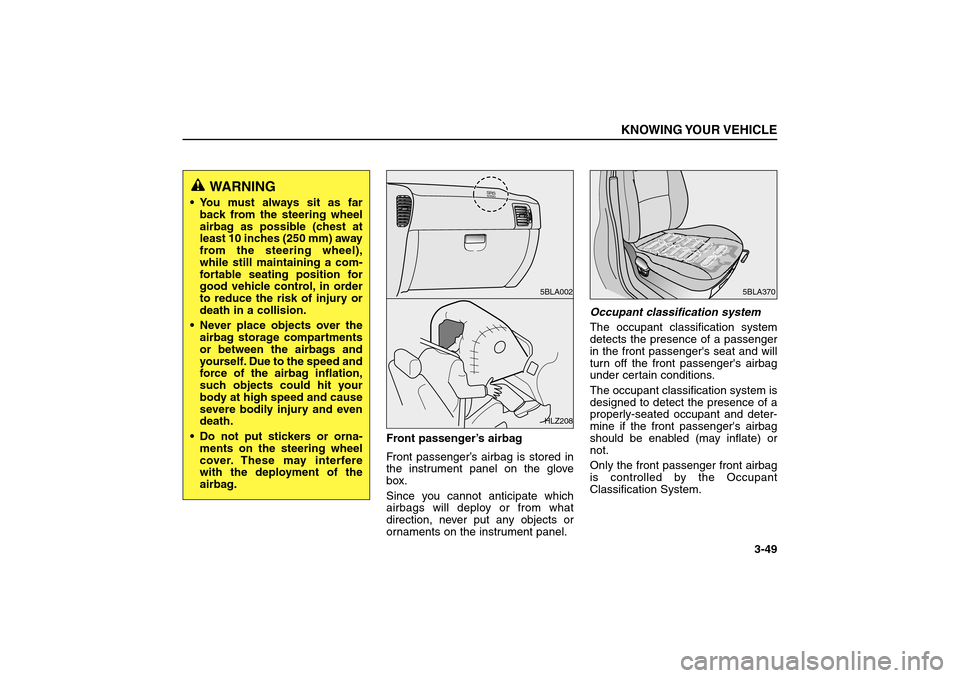
Front passenger’s airbag
Front passenger’s airbag is stored in
the instrument panel on the glove
box.
Since you cannot anticipate which
airbags will deploy or from what
direction, never put any objects or
ornaments on the instrument panel.Occupant classification system
The occupant classification system
detects the presence of a passenger
in the front passenger's seat and will
turn off the front passenger's airbag
under certain conditions.
The occupant classification system is
designed to detect the presence of a
properly-seated occupant and deter-
mine if the front passenger's airbag
should be enabled (may inflate) or
not.
Only the front passenger front airbag
is controlled by the Occupant
Classification System.
KNOWING YOUR VEHICLE
3-49
WARNING
You must always sit as far
back from the steering wheel
airbag as possible (chest at
least 10 inches (250 mm) away
from the steering wheel),
while still maintaining a com-
fortable seating position for
good vehicle control, in order
to reduce the risk of injury or
death in a collision.
Never place objects over the
airbag storage compartments
or between the airbags and
yourself. Due to the speed and
force of the airbag inflation,
such objects could hit your
body at high speed and cause
severe bodily injury and even
death.
Do not put stickers or orna-
ments on the steering wheel
cover. These may interfere
with the deployment of the
airbag.
SRSAIRBAG
5BLA002HLZ208
5BLA370
BL-ENG (CAN)-3.qxd 7/28/05 5:52 PM Page 49
Page 59 of 312
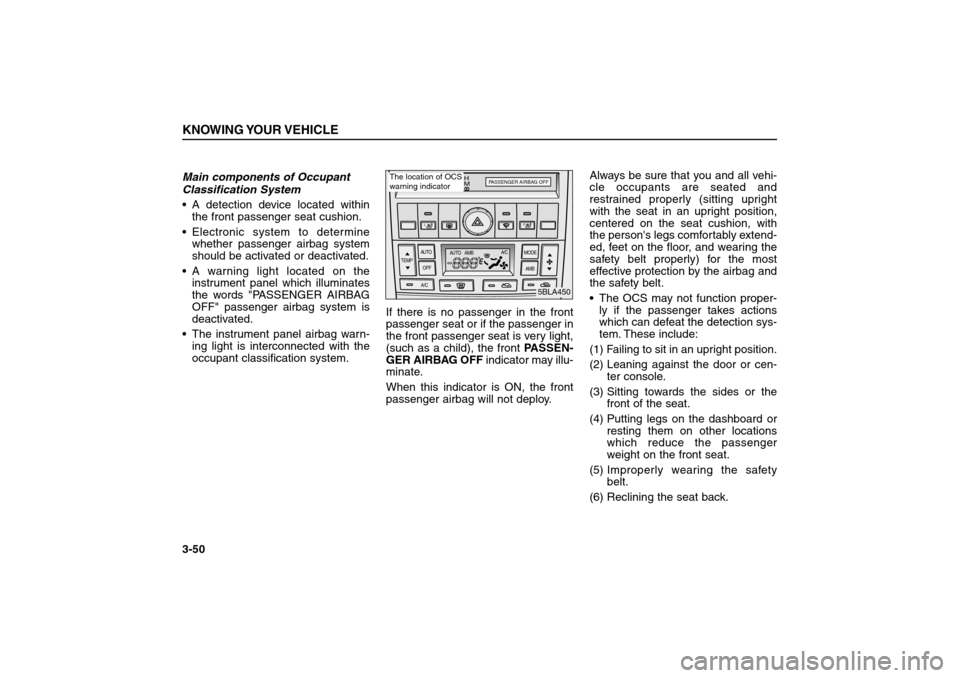
Main components of Occupant
Classification System
A detection device located within
the front passenger seat cushion.
Electronic system to determine
whether passenger airbag system
should be activated or deactivated.
A warning light located on the
instrument panel which illuminates
the words "PASSENGER AIRBAG
OFF" passenger airbag system is
deactivated.
The instrument panel airbag warn-
ing light is interconnected with the
occupant classification system.If there is no passenger in the front
passenger seat or if the passenger in
the front passenger seat is very light,
(such as a child), the front PASSEN-
GER AIRBAG OFFindicator may illu-
minate.
When this indicator is ON, the front
passenger airbag will not deploy.Always be sure that you and all vehi-
cle occupants are seated and
restrained properly (sitting upright
with the seat in an upright position,
centered on the seat cushion, with
the person's legs comfortably extend-
ed, feet on the floor, and wearing the
safety belt properly) for the most
effective protection by the airbag and
the safety belt.
The OCS may not function proper-
ly if the passenger takes actions
which can defeat the detection sys-
tem. These include:
(1) Failing to sit in an upright position.
(2) Leaning against the door or cen-
ter console.
(3) Sitting towards the sides or the
front of the seat.
(4) Putting legs on the dashboard or
resting them on other locations
which reduce the passenger
weight on the front seat.
(5) Improperly wearing the safety
belt.
(6) Reclining the seat back.KNOWING YOUR VEHICLE3-50
AUTO
AUTO AMB
OFF TEMPMODE
AMB
A/C
A/C
H
M
L
R
PASSENGER AIRBAG OFF
5BLA450
The location of OCS
warning indicator
BL-ENG (CAN)-3.qxd 7/28/05 5:52 PM Page 50
Page 60 of 312
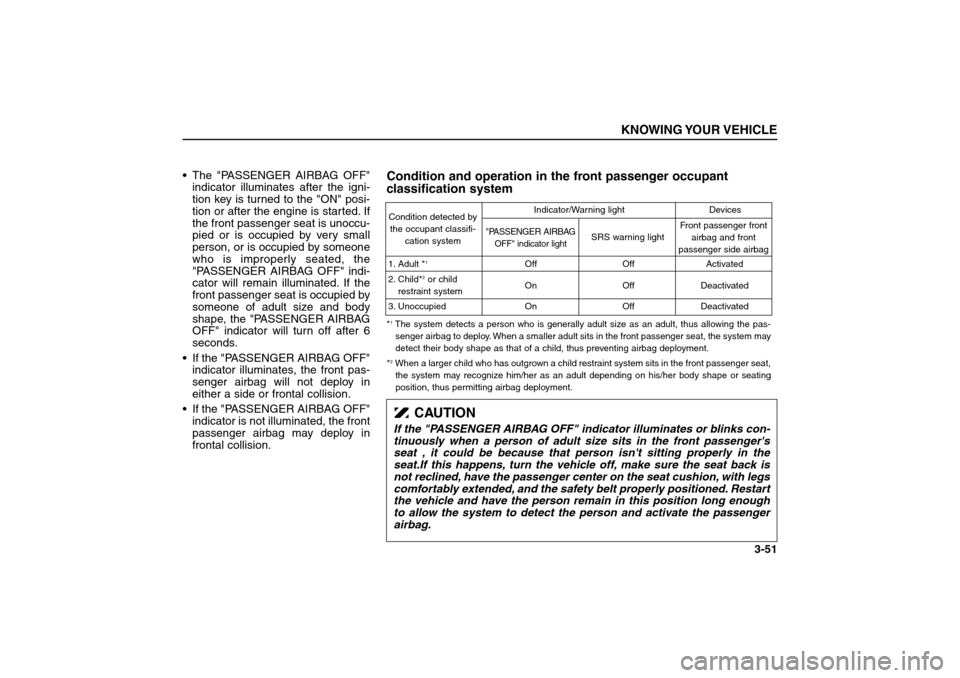
The "PASSENGER AIRBAG OFF"
indicator illuminates after the igni-
tion key is turned to the "ON" posi-
tion or after the engine is started. If
the front passenger seat is unoccu-
pied or is occupied by very small
person, or is occupied by someone
who is improperly seated, the
"PASSENGER AIRBAG OFF" indi-
cator will remain illuminated. If the
front passenger seat is occupied by
someone of adult size and body
shape, the "PASSENGER AIRBAG
OFF" indicator will turn off after 6
seconds.
If the "PASSENGER AIRBAG OFF"
indicator illuminates, the front pas-
senger airbag will not deploy in
either a side or frontal collision.
If the "PASSENGER AIRBAG OFF"
indicator is not illuminated, the front
passenger airbag may deploy in
frontal collision.
KNOWING YOUR VEHICLE
3-51
CAUTION
If the "PASSENGER AIRBAG OFF" indicator illuminates or blinks con-
tinuously when a person of adult size sits in the front passenger's
seat , it could be because that person isn't sitting properly in the
seat.If this happens, turn the vehicle off, make sure the seat back is
not reclined, have the passenger center on the seat cushion, with legs
comfortably extended, and the safety belt properly positioned. Restart
the vehicle and have the person remain in this position long enough
to allow the system to detect the person and activate the passenger
airbag.Condition and operation in the front passenger occupant
classification systemCondition detected by
the occupant classifi-
cation system
1. Adult *
1
2. Child*
2or child
restraint system
3. Unoccupied Off
On
OnOff
Off
OffActivated
Deactivated
Deactivated
"PASSENGER AIRBAG
OFF" indicator light
SRS warning lightFront passenger front
airbag and front
passenger side airbag Indicator/Warning light Devices
*1The system detects a person who is generally adult size as an adult, thus allowing the pas-
senger airbag to deploy. When a smaller adult sits in the front passenger seat, the system may
detect their body shape as that of a child, thus preventing airbag deployment.
*2When a larger child who has outgrown a child restraint system sits in the front passenger seat,
the system may recognize him/her as an adult depending on his/her body shape or seating
position, thus permitting airbag deployment.
BL-ENG (CAN)-3.qxd 7/28/05 5:52 PM Page 51